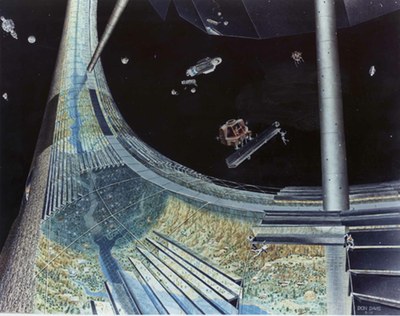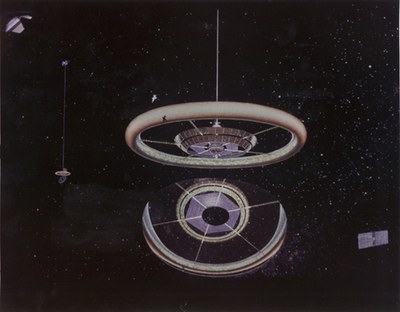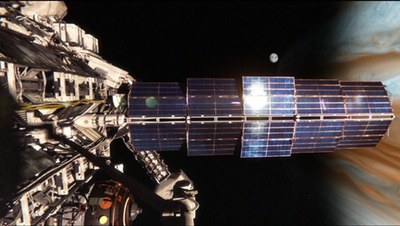Futures imperfectby Dwayne Day
|
| Blomkamp seems to have picked up on the theme of space as a playground for the rich and powerful. The giant Elysium space station, started in the late 21st century, is a haven for the rich by the middle of the 22nd century. |
Because the future (the future that I want, anyway) hasn’t gotten here fast enough, I like to watch science fiction movies focused on the near-future and featuring realistic depictions of spaceflight. Over the years I have reviewed many of them on The Space Review, from the good to the awful and everything in between. But in the coming months we are about to be treated to three very intriguing movies about near-term space travel that may offer the promise for some interesting discussion and reflection about the current state of human spaceflight.
Gravity
In 2006, Alfonso Cuarón directed one of the ten best science fiction movies of the last decade, Children of Men. Cuarón demonstrated the power of science fiction as a cultural mirror, creating a fictional situation and exploring its effects on humanity. The premise of the film was that no more children were being born in the world and as a result civilization was rapidly falling apart. People no longer saw a future for the world, and by extension, themselves. Nihilism and decay spread over the Earth. It was a powerfully thought-provoking movie.
Cuarón has returned to science fiction for his next movie, Gravity, starring George Clooney and Sandra Bullock as astronauts aboard the International Space Station as something goes terribly wrong. Although the scope of the film is less grand than Children of Men, if we are to judge from the trailer it will be an intense psychological and emotional movie.
The trailer seems slightly anachronistic, because it depicts a space shuttle and apparently the Hubble Space Telescope at the ISS, and the last shuttle flew in 2011. But Cuarón is a talented and thoughtful director, and thus there is reason to expect a great film.
Gravity premiers in October.
Elysium
In 2009, previously unknown South African director Neill Blomkamp surprised many people with an intense and clever movie about aliens living on Earth. District 9 had an interesting twist on the alien invasion film: one day a giant alien spaceship shows up on Earth, hovering over Johannesburg, South Africa. When humans finally venture aboard they find thousands of starving aliens, apparently a slave race that had been abandoned on the ship. The film took place twenty years after this event, when most of the aliens are confined to a slum, separated from humans, and are considered nothing more than a nuisance. The movie was a commentary about how we treat the lowest among us, and the divisions, often self-imposed, that prevent understandings between cultures.
Blomkamp has now returned to that theme, this time with a film that may make many libertarian space enthusiasts uncomfortable. The premise of Elysium is that humanity has now moved out into space, building a giant orbiting space station modeled on the conceptual space cities inspired by Gerard K. O’Neill in the 1970s. O’Neill envisioned cities to support the workers necessary to mine lunar materials and build massive solar power stations to beam energy to Earth. But nearly forty years later solar power satellites remain the subject of fanboy fantasies and most talk about “ordinary people” going into space concerns wealthy space tourists rather than the middle and working classes. Blomkamp seems to have picked up on the theme of space as a playground for the rich and powerful. The giant Elysium space station, started in the late 21st century, is a haven for the rich by the middle of the 22nd century. Echoing many earlier science fiction movies (Blade Runner, Wall-E, Silent Running) Earth is a dump, a hellhole for the poor and downtrodden, and someplace that people want to leave behind to decay.
Blomkamp has clearly taken much inspiration for his movie from some 1970s-era NASA artwork. As Kelsey Campbell-Dollaghan writing for Gizmodo has noted, many of the giant space station’s design features are practically copies of artwork produced by NASA nearly four decades ago.
Elysium:
 |
NASA-sponsored artwork by Rick Guidice:
 |
Elysium:
 |
NASA-sponsored artwork by Don Davis:
 |
Elysium:
 |
NASA-sponsored artwork by Don Davis:
 |
The movie’s website, which plays up the idea of spaceflight as available only for the rich and beautiful, can be found here.
Elysium premiers August 9.
Europa Report
Perhaps all you need to know about this movie is that the soundtrack is by Bear McCreary. McCreary is the incredibly talented musician who has composed the soundtracks for Battlestar Galactica and numerous other television shows, including several that are currently airing. He has tremendous range, able to incorporate various musical styles and instruments into his scores depending up on the emotional and visual requirements of the scene.
Europa Report focuses on a privately-funded mission to Jupiter’s moon Europa. Europa, as you may know, is suspected of harboring a vast ocean underneath an icy surface. The official poster includes the line: “Fear. Sacrifice. Contact.” And that’s pretty much what the trailer depicts. An astronaut goes under the ice (which is not going to be easy considering that it may be several kilometers thick), and encounters something bad.
According to a vague but highly enthusiastic review on io9, the film presents a very realistic depiction of human spaceflight, and it is interesting to compare the trailer to the trailer for Gravity, which looks a little more Hollywood glossy, probably due to a far larger budget. The film uses the now-tired “found footage” approach, something that we saw in another science fiction movie, Apollo 18, a couple of years ago, but it looks good.
The fictional corporate sponsor website for the expedition—although lacking in much content, is here.
Europa Report premiers August 2.
| Based upon the Elysium trailer, it looks like we are supposed to support the working class man who is striving to bring down the beautiful space colony in the sky. |
Of all of these movies, Elysium may offer the most food for thought for the space enthusiast community. One of the major contradictions of current plans for space tourism is that even if they work, they will be a far cry from the democratizing vision of human spaceflight that was first advanced by spaceflight visionaries in the 1970s. Those who have long griped that NASA only flies a few elites into space—Ph.D. engineers and doctors and military test pilots—haven’t really addressed the fact that space tourism really only substitutes another set of elites, the very rich, for the high achievers. Based upon the Elysium trailer, it looks like we are supposed to support the working class man who is striving to bring down the beautiful space colony in the sky.
On the other hand, both Europa Report and Gravity show more traditional approaches to human spaceflight. Europa Report may ostensibly depict a commercial spaceflight mission, but it still appears to be a scientific expedition similar to what a consortium of government space agencies would conduct. And neither of those adventures look like they end well.
